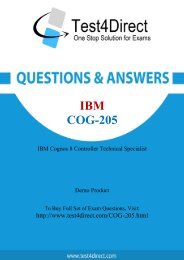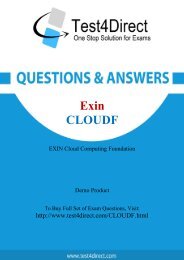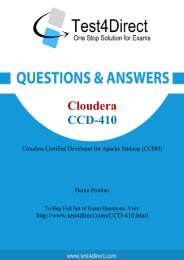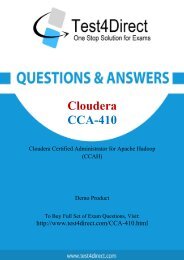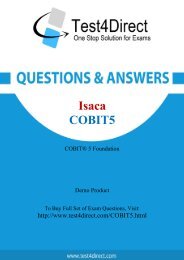Up-to-Date CCA-470 Exam BrainDumps
Test4Direct provides latest PDF questions of Cloudera CCA-470 exam. You have an opportunity to pass the Cloudera CCA-470 exam in one go. Test4Direct is most accurate source to prepare Cloudera CCA-470 exam as your success will become site’s responsibility after purchasing CCA-470 exam product. There are also lots of discounts and promotion offers that you can avail. Let’s try a free demo http://www.test4direct.com/CCA-470.html
Test4Direct provides latest PDF questions of Cloudera CCA-470 exam. You have an opportunity to pass the Cloudera CCA-470 exam in one go. Test4Direct is most accurate source to prepare Cloudera CCA-470 exam as your success will become site’s responsibility after purchasing CCA-470 exam product. There are also lots of discounts and promotion offers that you can avail. Let’s try a free demo http://www.test4direct.com/CCA-470.html
Create successful ePaper yourself
Turn your PDF publications into a flip-book with our unique Google optimized e-Paper software.
Cloudera<br />
<strong>CCA</strong>-<strong>470</strong><br />
Cloudera Certified Administra<strong>to</strong>r for Apache Hadoop<br />
CDH4 <strong>Up</strong>grade <strong>Exam</strong> (<strong>CCA</strong>H)<br />
Demo Product<br />
To Buy Full Set of <strong>Exam</strong> Questions, Visit:<br />
http://www.test4direct.com/<strong>CCA</strong>-<strong>470</strong>.html
Question: 1<br />
Which two updates occur when a client application opens a stream <strong>to</strong> begin a file write on a cluster<br />
running MapReduce v1 (MRv1)?<br />
A. Once the write stream closes on the DataNode, the DataNode immediately initiates a black report<br />
<strong>to</strong> the NameNode.<br />
B. The change is written <strong>to</strong> the NameNode disk.<br />
C. The metadata in the RAM on the NameNode is flushed <strong>to</strong> disk.<br />
D. The metadata in RAM on the NameNode is flushed disk.<br />
E. The metadata in RAM on the NameNode is updated.<br />
F. The change is written <strong>to</strong> the edits file.<br />
Question: 2<br />
Question: 3<br />
Answer: D, F<br />
Explanation:<br />
Note: Namenode s<strong>to</strong>res modifications <strong>to</strong> the filesystem as a log appended <strong>to</strong> a native filesystem file<br />
(edits). When a Namenode starts up, it reads HDFS state from an image file (fsimage) and then<br />
applies edits from edits log file. It then writes new HDFS state <strong>to</strong> (fsimage) and starts normal<br />
operation with an empty edits file. Since namenode merges fsimage and edits files only during start<br />
up, edits file could get very large over time on a large cluster. Another side effect of larger edits file is<br />
that next restart of Namenade takes longer.<br />
The secondary namenode merges fsimage and edits log periodically and keeps edits log size with in a<br />
limit. It is usually run on a different machine than the primary Namenode since its memory<br />
requirements are on the same order as the primary namemode. The secondary namenode is started<br />
by bin/start-dfs.sh on the nodes specified in conf/masters file.<br />
For a MapReduce job, on a cluster running MapReduce v1 (MRv1), what’s the relationship between<br />
tasks and task templates?<br />
A. There are always at least as many task attempts as there are tasks.<br />
B. There are always at most as many tasks attempts as there are tasks.<br />
C. There are always exactly as many task attempts as there are tasks.<br />
D. The developer sets the number of task attempts on job submission.<br />
What action occurs au<strong>to</strong>matically on a cluster when a DataNode is marked as dead?<br />
Answer: C<br />
A. The NameNode forces re-replication of all the blocks which were s<strong>to</strong>red on the dead DataNode.<br />
B. The next time a client submits job that requires blocks from the dead DataNode, the JobTracker<br />
receives no heart beats from the DataNode. The JobTracker tells the NameNode that the DataNode is<br />
dead, which triggers block re-replication on the cluster.
C. The replication fac<strong>to</strong>r of the files which had blocks s<strong>to</strong>red on the dead DataNode is temporarily<br />
reduced, until the dead DataNode is recovered and returned <strong>to</strong> the cluster.<br />
D. The NameNode informs the client which write the blocks that are no longer available; the client<br />
then re-writes the blocks <strong>to</strong> a different DataNode.<br />
Question: 4<br />
Answer: A<br />
Explanation:<br />
How NameNode Handles data node failures?<br />
NameNode periodically receives a Heartbeat and a Blockreport from each of the DataNodes in the<br />
cluster. Receipt of a Heartbeat implies that the DataNode is functioning properly. A Blockreport<br />
contains a list of all blocks on a DataNode. When NameNode notices that it has not recieved a<br />
hearbeat message from a data node after a certain amount of time, the data node is marked as dead.<br />
Since blocks will be under replicated the system begins replicating the blocks that were s<strong>to</strong>red on the<br />
dead datanode. The NameNode Orchestrates the replication of data blocks from one datanode <strong>to</strong><br />
another. The replication data transfer happens directly between datanodes and the data never<br />
passes through the namenode.<br />
Note: If the Name Node s<strong>to</strong>ps receiving heartbeats from a Data Node it presumes it <strong>to</strong> be dead and<br />
any data it had <strong>to</strong> be gone as well. Based on the block reports it had been receiving from the dead<br />
node, the Name Node knows which copies of blocks died along with the node and can make the<br />
decision <strong>to</strong> re-replicate those blocks <strong>to</strong> other Data Nodes. It will also consult the Rack Awareness<br />
data in order <strong>to</strong> maintain the two copies in one rack, one copy in another rack replica rule when<br />
deciding which Data Node should receive a new copy of the blocks.<br />
Reference:<br />
24 Interview Questions & Answers for Hadoop MapReduce developers, How NameNode Handles<br />
data node failures’<br />
How does the NameNode know DataNodes are available on a cluster running MapReduce v1 (MRv1)<br />
A. DataNodes listed in the dfs.hosts file. The NameNode uses as the definitive list of available<br />
DataNodes.<br />
B. DataNodes heartbeat in the master on a regular basis.<br />
C. The NameNode broadcasts a heartbeat on the network on a regular basis, and DataNodes<br />
respond.<br />
D. The NameNode send a broadcast across the network when it first starts, and DataNodes respond.<br />
Answer: B<br />
Explanation:<br />
How NameNode Handles data node failures?<br />
NameNode periodically receives a Heartbeat and a Blockreport from each of the DataNodes in the<br />
cluster. Receipt of a Heartbeat implies that the DataNode is functioning properly. A Blockreport<br />
contains a list of all blocks on a DataNode. When NameNode notices that it has not recieved a<br />
hearbeat message from a data node after a certain amount of time, the data node is marked as dead.<br />
Since blocks will be under replicated the system begins replicating the blocks that were s<strong>to</strong>red on the<br />
dead datanode. The NameNode Orchestrates the replication of data blocks from one datanode <strong>to</strong><br />
another. The replication data transfer happens directly between datanodes and the data never<br />
passes through the namenode.<br />
Reference:
24 Interview Questions & Answers for Hadoop MapReduce developers, How NameNode Handles<br />
data node failures?<br />
Question: 5<br />
Which three distcp features can you utilize on a Hadoop cluster?<br />
A. Use distcp <strong>to</strong> copy files only between two clusters or more. You cannot use distcp <strong>to</strong> copy data<br />
between direc<strong>to</strong>ries inside the same cluster.<br />
B. Use distcp <strong>to</strong> copy HBase table files.<br />
C. Use distcp <strong>to</strong> copy physical blocks from the source <strong>to</strong> the target destination in your cluster.<br />
D. Use distcp <strong>to</strong> copy data between direc<strong>to</strong>ries inside the same cluster.<br />
E. Use distcp <strong>to</strong> run an internal MapReduce job <strong>to</strong> copy files.<br />
Question: 6<br />
Answer: B, D, E<br />
Explanation:<br />
DistCp (distributed copy) is a <strong>to</strong>ol used for large inter/intra-cluster copying. It uses Map/Reduce <strong>to</strong><br />
effect its distribution, error handling and recovery, and reporting. It expands a list of files and<br />
direc<strong>to</strong>ries in<strong>to</strong> input <strong>to</strong> map tasks, each of which will copy a partition of the files specified in the<br />
source list. Its Map/Reduce pedigree has endowed it with some quirks in both its semantics and<br />
execution.<br />
Reference:<br />
Hadoop DistCp Guide<br />
How does HDFS Federation help HDFS Scale horizontally?<br />
A. HDFS Federation improves the resiliency of HDFS in the face of network issues by removing the<br />
NameNode as a single-point-of-failure.<br />
B. HDFS Federation allows the Standby NameNode <strong>to</strong> au<strong>to</strong>matically resume the services of an active<br />
NameNode.<br />
C. HDFS Federation provides cross-data center (non-local) support for HDFS, allowing a cluster<br />
administra<strong>to</strong>r <strong>to</strong> split the Block S<strong>to</strong>rage outside the local cluster.<br />
D. HDFS Federation reduces the load on any single NameNode by using the multiple, independent<br />
NameNode <strong>to</strong> manage individual pars of the filesystem namespace.<br />
Answer: D<br />
Explanation:<br />
HDFS FederationIn order <strong>to</strong> scale the name service horizontally, federation uses multiple<br />
independent Namenodes/Namespaces. The Namenodes are federated, that is, the Namenodes are<br />
independent and don’t require coordination with each other. The datanodes are used as common<br />
s<strong>to</strong>rage for blocks by all the Namenodes. Each datanode registers with all the Namenodes in the<br />
cluster. Datanodes send periodic heartbeats and block reports and handles commands from the<br />
Namenodes.<br />
Reference:<br />
Apache Hadoop 2.0.2-alpha<br />
http://hadoop.apache.org/docs/current/
Question: 7<br />
Choose which best describe a Hadoop cluster's block size s<strong>to</strong>rage parameters once you set the HDFS<br />
default block size <strong>to</strong> 64MB?<br />
A. The block size of files in the cluster can be determined as the block is written.<br />
B. The block size of files in the Cluster will all be multiples of 64MB.<br />
C. The block size of files in the duster will all at least be 64MB.<br />
D. The block size of files in the cluster will all be the exactly 64MB.<br />
Question: 8<br />
Answer: D<br />
Explanation:<br />
Note: What is HDFS Block size? How is it different from traditional file system block size?<br />
In HDFS data is split in<strong>to</strong> blocks and distributed across multiple nodes in the cluster. Each block is<br />
typically 64Mb or 128Mb in size. Each block is replicated multiple times. Default is <strong>to</strong> replicate each<br />
block three times. Replicas are s<strong>to</strong>red on different nodes. HDFS utilizes the local file system <strong>to</strong> s<strong>to</strong>re<br />
each HDFS block as a separate file. HDFS Block size can not be compared with the traditional file<br />
system block size.<br />
Which MapReduce daemon instantiates user code, and executes map and reduce tasks on a cluster<br />
running MapReduce v1 (MRv1)?<br />
A. NameNode<br />
B. DataNode<br />
C. JobTracker<br />
D. TaskTracker<br />
E. ResourceManager<br />
F. ApplicationMaster<br />
G. NodeManager<br />
Answer: D<br />
Explanation:<br />
A TaskTracker is a slave node daemon in the cluster that accepts tasks (Map, Reduce and Shuffle<br />
operations) from a JobTracker. There is only One Task Tracker process run on any hadoop slave node.<br />
Task Tracker runs on its own JVM process. Every TaskTracker is configured with a set of slots, these<br />
indicate the number of tasks that it can accept. The TaskTracker starts a separate JVM processes <strong>to</strong> do<br />
the actual work (called as Task Instance) this is <strong>to</strong> ensure that process failure does not take down the<br />
task tracker. The TaskTracker moni<strong>to</strong>rs these task instances, capturing the output and exit codes.<br />
When the Task instances finish, successfully or not, the task tracker notifies the JobTracker. The<br />
TaskTrackers also send out heartbeat messages <strong>to</strong> the JobTracker, usually every few minutes, <strong>to</strong><br />
reassure the JobTracker that it is still alive. These message also inform the JobTracker of the number<br />
of available slots, so the JobTracker can stay up <strong>to</strong> date with where in the cluster work can be<br />
delegated.<br />
Note: How many Daemon processes run on a Hadoop system?<br />
Hadoop is comprised of five separate daemons. Each of these daemon run in its own JVM. Following
3 Daemons run on Master nodes NameNode - This daemon s<strong>to</strong>res and maintains the metadata for<br />
HDFS.<br />
Secondary NameNode - Performs housekeeping functions for the NameNode.<br />
JobTracker - Manages MapReduce jobs, distributes individual tasks <strong>to</strong> machines running the Task<br />
Tracker.<br />
Following 2 Daemons run on each Slave nodes<br />
DataNode – S<strong>to</strong>res actual HDFS data blocks.<br />
TaskTracker - Responsible for instantiating and moni<strong>to</strong>ring individual Map and Reduce tasks.<br />
Reference:<br />
24 Interview Questions & Answers for Hadoop MapReduce developers, What is a Task Tracker in<br />
Hadoop? How many instances of TaskTracker run on a Hadoop Cluster
THANKS FOR TRYING THE DEMO OF OUR PRODUCT<br />
Visit Our Site <strong>to</strong> Purchase the Full Set of Actual <strong>CCA</strong>-<strong>470</strong> <strong>Exam</strong> Questions With Answers.<br />
http://www.test4direct.com/<strong>CCA</strong>-<strong>470</strong>.html<br />
We Also Provide Practice <strong>Exam</strong> Software That Simulates Real <strong>Exam</strong> Environment And Has<br />
Many Self-Assessment Features. Download Free Product Demo From:<br />
http://www.test4direct.com/<strong>CCA</strong>-<strong>470</strong>.html<br />
Money Back Guarantee<br />
Check Out Our Cus<strong>to</strong>mer Testimonials




